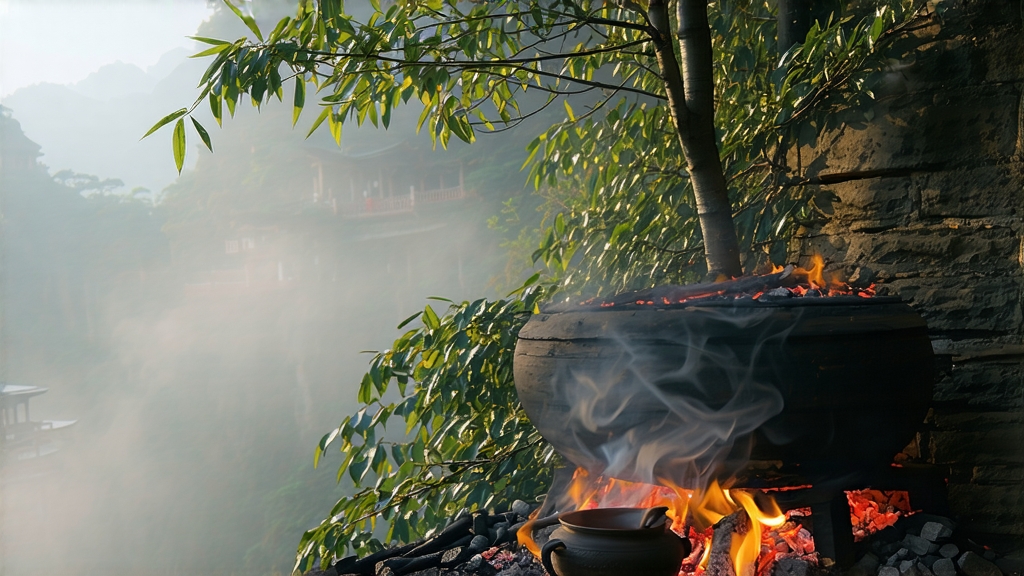
High in the mist-wrapped Wuyi Mountains of northern Fujian, where sheer cliffs drop into the Jiuqu Stream and every dawn smells of cedar and wet stone, tea makers still speak of Lapsang Souchong with the same reverence a Burgundian winemaker reserves for Romanée-Conti. To most outsiders the name evokes a pungent, almost tarry liquor reminiscent of single-malt whisky and burnt pine; to the villagers of Tongmu Guan, the last settlement inside a national nature reserve, it is simply “zhengshan xiaozhong”—the original, smoke-kissed heart of Chinese black tea.
History: from Ming-era garrison to global icon
The story begins in 1646, when Qing armies pressed southward and Ming loyalists retreated into the Wuyi canyons. Legend claims that tea farmers, ordered to surrender their fresh leaf to quartering troops, hastily dried the harvest over pine fires so it would keep during the march. The accidental smoke infusion proved irresistible to the Dutch traders who first carried the cargo to Europe, where “Bohea Lapsang” became the fashionable drink of London coffee-houses by the 1660s. Samuel Pepys mentions “a cup of the China drink called Lapu” in his diary; Catherine of Braganza, Charles II’s tea-loving queen, is said to have perfumed her boudoir with its scent. Over three centuries the leaf travelled from imperial tribute to breakfast staple, yet only within the 45 km² core of Tongmu Guan can the authentic “zhengshan” (original mountain) style still be made; every leaf picked outside that radius is merely “wai shan” and forbidden the coveted name.
Micro-terroir: why the canyon matters
Tongmu Guan sits at 27° N, 800–1 300 m above sea level, where subtropical monsoons collide with cool air sliding off the Huanggang summit. Annual rainfall exceeds 2 300 mm, humidity hovers at 85 % and the temperature amplitude between day and night can top 15 °C—ideal for slow accumulation of theaflavins and linalool. Soils are a friable, mineral-rich laterite strewn with weathered tuff and quartz; the same volcanic parent rock that gifts Wuyi oolong’s “yan yun” (rock rhyme) lends Lapsang Souchong a crisp, iron-note finish. Around the village, semi-wild groves of C. sinensis var. bohea root themselves in crevices once trod by Ming soldiers; many bushes are 80–120 years old, their gnarled trunks as thick as a man’s wrist.
Leaf hierarchy: four grades you need to know
- Zhengshan Xiaozhong (Original Mountain Lapsang) – picked from pre-Qingming buds and the first leaf, gently withered over pine embers for 8–10 hours; the smoke is subtle, more resinous than resin, and the cup tastes of longan, dried apricot and a whisper of wet slate.
- Wuyi Smoked Lapsang – same cultivar but harvested after Guyu, given a heavier smoke for export; think pipe tobacco, caramelised fig and campfire.
- Unsmoked Lapsang (frequently mis-labelled “Wild Lapsang”) – withered and baked like a traditional black tea, yielding a honeyed, muscatel liquor reminiscent of a high-grade Dian Hong yet still carrying the Wuyi minerality.
- Pine Tips Lapsang – a modern craft version where only the tender tips are used and smoke exposure is reduced to 30 minutes; bright, peachy, almost white-tea-like elegance.
Craft: turning green leaf into pine-scented velvet
Plucking begins at dawn when the mountain mist is still milky; only the standard “two leaves and a bud” or, for top grades, the unopened bud alone is taken. The baskets are bamboo, never plastic, to avoid tainting the aromatics. Once back in the wooden long-house, the leaf is spread 3 cm deep on rattan trays set 2 m above a ground-level hearth of Masson pine and cedar roots. The fire is kept at 80–90 °C, low enough to avoid scorching yet hot enough to drive off moisture; intermittent wisps of cool canyon air are admitted through shuttered windows, creating a rhythmic expansion and contraction of the